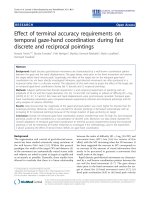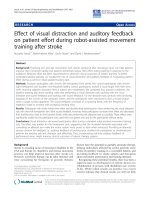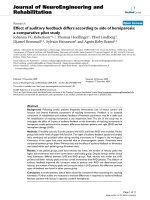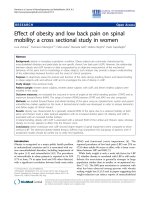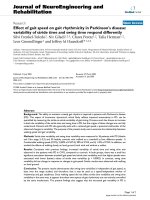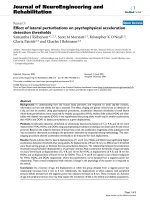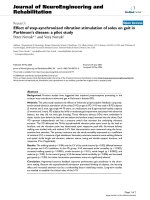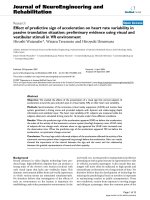Báo cáo hóa học: " Effect of Purity and Substrate on Field Emission Properties of Multi-walled Carbon Nanotubes" pdf
Bạn đang xem bản rút gọn của tài liệu. Xem và tải ngay bản đầy đủ của tài liệu tại đây (297.06 KB, 6 trang )
NANO EXPRESS
Effect of Purity and Substrate on Field Emission Properties
of Multi-walled Carbon Nanotubes
R. B. Rakhi Æ K. Sethupathi Æ S. Ramaprabhu
Received: 15 March 2007 / Accepted: 24 May 2007 / Published online: 21 June 2007
Ó to the authors 2007
Abstract Multi-walled carbon nanotubes (MWNT) have
been synthesized by chemical vapour decomposition
(CVD) of acetylene over Rare Earth (RE) based AB
2
(DyNi
2
) alloy hydride catalyst. The as-grown carbon na-
notubes were purified by acid and heat treatments and
characterized using powder X-ray diffraction, Scanning
Electron Microscopy, Transmission Electron Microscopy,
Thermo Gravimetric Analysis and Raman Spectroscopy.
Fully carbon based field emitters have been fabricated by
spin coating a solutions of both as-grown and purified
MWNT and dichloro ethane (DCE) over carbon paper with
and without graphitized layer. The use of graphitized car-
bon paper as substrate opens several new possibilities for
carbon nanotube (CNT) field emitters, as the presence of
the graphitic layer provides strong adhesion between the
nanotubes and carbon paper and reduces contact resistance.
The field emission characteristics have been studied using
an indigenously fabricated set up and the results are dis-
cussed. CNT field emitter prepared by spin coating of the
purified MWNT–DCE solution over graphitized carbon
paper shows excellent emission properties with a fairly
stable emission current over a period of 4 h. Analysis of the
field emission characteristics based on the Fowler–Nord-
heim (FN) theory reveals current saturation effects at high
applied fields for all the samples.
Keywords Multi-walled carbon nanotubes Á DyNi
2
alloy
hydride Á Spin coating Á Dichloro ethane Á Graphitized
carbon paper Á CNT field emitter Á Fowler–Nordheim
theory
Introduction
Carbon nanotubes (CNTs) have been considered as one of
the best candidates for field emission due to their unique
properties such as high aspect ratio, chemical inertness,
high mechanical strength and high electrical conductivity
[1, 2]. In spite of such excellent characteristics, the
realization of CNT based vacuum microelectronics has
been limited due to the absence of a stable film fabrica-
tion process over a suitable substrate. The mechanism of
field induced electron emission from a nanotube is
understood to be due to the applied electric field under-
going an increase at the tip of the CNT, which is often
referred to as the field enhancement factor (b). The value
of b depends on the length, radius and type of the
structure [1, 3, 4]. Both single walled nanotubes (SWNT)
and multi walled nanotubes (MWNT) have been reported
as excellent field emitters at low operating voltages [1–5].
Carbon nanotubes are usually prepared by arc evaporation
[6], laser ablation [7] or metal catalyzed CVD [8]. Cat-
alysts with large surface area having active catalytic
centers are vital for the large scale production of carbon
nanotubes using CVD [9].
CNT based field emitters have been fabricated using
different methods such as direct growth [10], screen
printing [11], suspension filtering [12], electrophoresis [13]
and spray method [14, 15]. The major disadvantage with
screen printing method is that one cannot study the intrinsic
field emission nature of the CNTs due to the surface
R. B. Rakhi Á S. Ramaprabhu (&)
Alternative Energy Technology Laboratory, Department of
Physics, Indian Institute of Technology Madras, Chennai
600036, India
e-mail:
R. B. Rakhi Á K. Sethupathi
Low Temperature Laboratory, Department of Physics, Indian
Institute of Technology Madras, Chennai 600036, India
123
Nanoscale Res Lett (2007) 2:331–336
DOI 10.1007/s11671-007-9067-3
modification of nanotubes. Moreover, there will be sub-
stantial degradation of emission tips, which cannot be
avoided [11]. In all other methods weak adhesion of CNTs
to the substrate is a serious draw back, which often leads to
catastrophic vacuum breakdown or arcing during device
operation [16, 17]. In addition, the electronic resistance
between the CNTs and the substrate results in joule heating
of the interface. This damages the electrical contact
between the emitters and the substrate, there by increasing
the voltage required for emission over extended periods
[17, 18].
In order to overcome such undesirable effects, we have
fabricated a fully carbon based field emitter by spin
coating a solution of MWNT over graphitized carbon
paper. In this paper we report the fabrication of both as-
grown and purified MWNT based field emitters by spin
coating method over carbon paper with and without a
graphitized layer. The purpose of this paper is to find out
how the field emission properties are influenced by the
purity of the MWNT and by the presence of the graphitic
layer between the MWNT and the substrate (carbon pa-
per). The field emission properties have been studied and
the results have been discussed. The results show that this
method opens several new possibilities for field emission
devices.
Experimental
MWNT were synthesized by the decomposition of acety-
lene over RE based AB
2
(DyNi
2
) alloy hydride powders
using a fixed- bed catalytic reactor as discussed in previous
work [19]. The as-prepared MWNT were purified by air
oxidation followed by acid treatment [19, 20]. The samples
were heated in air at 400 °C for 3 h to remove the amor-
phous carbon, lead to expose the catalytic metal surface.
The catalytic impurities were then removed by refluxing
with concentrated HNO
3
for 24 h, followed by washing
with de-ionized water and then the sample was dried in air
for 30 min at 100 °C. The crystallinity and purity of the
samples were verified by XRD (Cu-K
a
radiation) and
thermo gravimetric measurements (20 °C/min). The sam-
ples were characterized using Raman spectroscopy, SEM
and TEM.
The graphitized carbon paper is a double layer struc-
tured gas diffusion layer porous carbon paper which
consists of a macroporous layer of carbon fiber paper
(SGL, Germany) and a microporous layer of carbon black
powder and a hydrophobic agent. The carbon black
powder enhances an intimate electronic contact between
the CNTs and the macroporous carbon paper. The
graphitized carbon paper was prepared by deposition of a
mixture of carbon black and poly-tetrafluoroethylene
powders onto carbon paper in combination with a sub-
sequent rolling process.
For the fabrication of field emission arrays of randomly
oriented as-grown MWNT over carbon paper, as-grown
MWNT were first dispersed in 1, 2 dichloroethane (DCE).
DCE helps the dispersion of MWNT without surface
modification, besides being volatile [14, 15]. The disper-
sion process involved the ultrasonication of 50 mg of
MWNT in 10 ml of DCE for 1 h, followed by centrifu-
gation at a speed of 5,000 rpm for 30 min to precipitate the
undissolved MWNT. After decanting the supernatants, the
as-grown MWNT-DCE solution was spin coated on the
graphitized carbon paper at a speed of 3,200 rpm at room
temperature to obtain a uniform distribution of randomly
oriented MWNT on the graphitized carbon paper (Sample
A). Sample B was prepared by spin coating of the as-grown
MWNT-DCE solution over the carbon paper without the
graphitized layer. Using the same method, purified MWNT
were also spin coated over the graphitized carbon paper, to
obtain field emission arrays of randomly oriented purified
MWNT (Sample C). Sample D was prepared by spin
coating of the purified MWNT-DCE solution over the
carbon paper with out the graphitized layer.
The field emission characteristics were studied using an
indigenously fabricated set-up (Fig. 1). It consists of a
cylindrical gold coated copper anode of 1 cm diameter and
a stainless steel (SS) cathode. The carbon films were kept
placed over the cathode and electrical contacts were made
using silver paste. A dielectric spacer with a hole of 1 mm
diameter was kept over the film. The whole arrangement
was kept inside a vacuum chamber and all measurements
were carried out at a base pressure of 2 · 10
–6
torr. The
Micrometer translation
stage
Anode (+ ve)
Cathode (- ve)
CNT film
Fig. 1 Schematic diagram of the field emission set up housed inside
the vacuum chamber
332 Nanoscale Res Lett (2007) 2:331–336
123
distance between the emitting surface and the anode could
be adjusted using a micrometer controlled translational
stage and in the case of samples A and B the distance was
held at 400 lm and for samples B and D, the separation
was 500 lm. A DC power source was used for sourcing the
voltage up to 2,000 V and current was measured with nA
sensitivity.
Results and Discussion
The powder X-ray diffraction (XRD) patterns were ob-
tained using an X’pert PRO, PANalytical diffractometer
with nickel-filtered Cu Ka radiation under ambient air
and scanning in the 2h range of 10–90°, in steps of
0.05°. X-ray diffraction pattern of DyNi
2
alloy shows the
formation of single phase with a C 15 type cubic
structure. XRD pattern of as-prepared CNTs using DyNi
2
alloy hydride catalyst shows the presence of the catalytic
impurities, while the removal of these impurities can be
verified from the XRD pattern of for purified CNTs.
These results have been explained in detail in our pre-
vious work [21].
FT-Raman Spectroscopy studies were carried out on as-
grown and purified MWNT, using WiTec GmbH confocal
Raman microscope using argon ion laser having an exci-
tation wavelength of 514.5 nm. Fig. 2a shows the Raman
spectra of as-grown MWNT and Fig. 2b represents that of
purified MWNT. Even though, similar peaks are observed
in both the spectra, the spectral peaks are sharper in the
case of purified MWNT. Its spectrum consists of two peaks
at 1,595.16 cm
–1
and 1,345.2 cm
–1
, which are designated
as the tangential modes of CNTs. The peak at 1,595.16 cm
–
1
is due to the Raman-active E
2g
mode analogous to that of
graphite, while that at 1345.2 cm
–1
corresponds to that of
disordered carbon.
Figure 3a and b show respectively the SEM images
(SEM; JEOL JSM 840 A) of as-grown and purified CNTs
obtained by the catalytic decomposition of acetylene over
hydrogen storage RE based AB
2
alloy hydride catalyst.
From the SEM image, it is evident that the packing density
of carbon nanotubes is very high. As the bottom layer of
the deposits inside the quartz tube were left out, not many
of the catalytic particles were seen in the SEM image,
unlike those reported by Gao et al. [22]. TEM images
(Philips Electron Microscope, acceleration voltage
120 KV) of as-grown and purified MWNT are shown in
Fig. 3c and d, respectively. The TEM micrograph shows
that the nanotubes have an outer diameter of about 30 nm
and an inner diameter of about 10 nm.
The as-grown and purified samples were analyzed for
their total carbon content by thermogravimetry in air
(20 °C min
–1
) employing a Perkin-Elmer TGA 7 ana-
lyzer. A slight weight loss is observed below 500 °C for
the purified sample which is due to the burning of
amorphous carbon. Weight loss between 500°C and
700°C is assigned to the burning of MWNT. Final
residual weight of 1.5% was obtained for the purified
MWNT. The purity of the purified sample is about 95%
whereas the TG curve for the as-grown MWNT indicates
a purity of only 21%. The yield of MWNT is defined as
the ratio of weight loss between 500 °C and 700 °C to the
weight that remain at 850 °C. This is a measure of the
ratio of the weight gain by MWNT to the weight of the
catalytic powder. From the TG curves the yield of
MWNT is estimated to be about 40% [21].
Figure 4a shows the field emission current density as a
function of applied field for samples A, B, C and D. The
corresponding Fowler–Nordheim (FN) plots are shown in
Fig. 4b. Field emission by the samples have been analyzed
using the Fowler–Nordheim theory, according to which
emission current density (J) of a metal tip is expressed as a
function of the local electric field (E
local
) and the work
function (F) of the emitter tip. i.e.
1200 1400 1600 1800
460
480
500
520
540
560
580
1595.19 cm
-1
1349.5 cm
-1
)stinu .bra( ytisnetnI
raman shift (cm
-1
)
raman shift (cm
-1
)
1000 1200 1400 1600 1800 2000
350
400
450
500
550
600
650
1349.2 cm
-1
1582.65 cm
-1
)stinu .bra( ytisnetni
(a)
(b)
Fig. 2 (a) Raman spectrum of as-grown MWNT, (b) Raman
spectrum of purified MWNT
Nanoscale Res Lett (2007) 2:331–336 333
123
J /
E
2
local
.
U
exp
ÀBU
3
2
.
E
local
where B = 6.83 · 10
9
VeV
–3/2
m
–1
. In the present case,
for all the samples, emission occurs from multiple emitters
and hence the measured current is an average of currents
due to individual emitters. The exact analysis of field
emission characteristics of the samples is a tedious task, as
the work function of the individual emitters may be dif-
ferent. Also the local field on each emitter tip may vary.
The local field E
local
is related to the macroscopic applied
field E by a dimensionless geometrical enhancement factor
(b)as
E
local
¼ b E
The value of b has been determined from the slope of
the FN plot using the relation
b ¼
BU
3
2
d
slope
where d is the distance of the anode from the emitting
surface. The work function of the nanotube is assumed to
be 5.0 eV (that of graphite) for comparison of the samples.
The turn-on field, i.e. the applied field at which emission
current density becomes 10 lA/cm
2
, the threshold field at
an emission current density of 0.2 mA/cm
2
and the field
enhancement factor b, for the samples are listed in Table 1.
Sample C shows superior emission properties compared to
samples A, B and D and this can be attributed to both the
purity of the MWNT and the presence of the graphitized
layer between the nanotubes and carbon paper in Sample
C. The absence of the graphitized layer between the
MWNT and carbon paper in samples B and D adversely
affects their performance. Moreover, for samples A and B,
the presence of catalytic impurities leads to weak adhesion
of CNTs to the substrate, which results in their poor per-
formance.
It is clearly seen from Fig. 4b that for all the four
samples, the FN plot has two distinct slopes. The slope in
the high field region is much lower than that in the low
field regime. This current saturation behavior at high field
regime may be attributed to a number of mechanisms [1,
12, 23, 24]. Among them are vacuum space charge effect,
changes in local density of states at the emitter’s tip, solid
state transport, interaction among adjacent tubes and
adsorption/desorption of gaseous species even under high
vacuum conditions due to emission assisted surface reac-
tion processes [25–27].
The current stability of the samples was monitored
continuously for a period of 4 h at a current density of
0.2 mA/cm
–2
. The emission current remained fairly con-
stant for samples A and C. The fluctuation in emission
current for sample A was within 4% and that of sample C
was within 1%. This indicates that there is an improvement
Fig. 3 (a) SEM image of the
as-grown MWNT, (b) SEM
image of the purified MWNT,
(c) TEM image of the as-grown
MWNT, (d) TEM image of the
purified MWNT
334 Nanoscale Res Lett (2007) 2:331–336
123
in the field emission characteristics upon purification of
MWNT. In the case of the other two samples (B and D),
fluctuations were very high. Visual inspection of the sam-
ples after the current stability studies revealed that the
morphology of the samples A and C remain intact and that
of samples B and D got damaged. Also, the emission
characteristics of samples A and C were exactly repro-
ducible after the current stability studies, which reveal that
the average number of active emission sites of the samples
remains fairly constant throughout the study. The weak
adhesion of CNTs to the substrate due to the absence of the
graphitized layer is responsible for the damage of samples
B and D. However, in order to bring out the exact dynamics
behind the emission process further studies are required.
Conclusions
MWNT with a purity of 95% have been prepared by the
pyrolysis of acetylene over DyNi
2
alloy hydride catalyst by
CVD technique. Fully carbon based field emitters have
been fabricated by spin coating a solution of MWNT and
dichloroethane (DCE) over carbon paper with and without
graphitic layer. The field emission properties of CNT film
prepared by spin coating of the purified MWNT–DCE
solution over graphitized carbon paper are superior com-
pared to the other samples, due to the purity of the carbon
nanotubes and the presence of the graphitic layer which
provides better adhesion between the CNTs and the sub-
strate. It shows excellent field emission properties with a
fairly stable emission current over a period of 4 h. All the
samples show current saturation effects. The use of
graphitized carbon paper as substrate opens several new
possibilities for CNT field emitters, with reduced contact
resistance.
Acknowledgement The authors are grateful to IITM and DRDO for
financial assistance. One of the authors, R.B Rakhi wishes to thank
Council of Scientific and Industrial Research (CSIR) India, for the
financial assistance provided in the form of a senior research fel-
lowship.
References
1. J.M. Bonard, J.P. Salvetat, T. Stockli, L. Forro, A. Chaelain,
Appl. Phys. A 69, 245 (1999)
2. S. Kyung, Y. Lee, C. Kim J. Lee, G. Yeom, Carbon 44, 1530
(2006)
3. Y. Cheng, O. Zhou, C.R. Physique 4, 1021 (2003)
2.1 2.4 2.7 3.0 3.3 3.6 3.9 4.2 4.5 4.8 5.1
0.0
0.2
0.4
0.6
0.8
1.0
1.2
1.4
mc
/
Am(J
2
)
E(V/ µ m)
as-grown with GDL
as-grown without GDL
pure with G DL
pure with out GD L
0.0005 0.0006 0.0007 0.0008 0.0009
-17
-16
-15
-14
-13
-12
-11
V/I(
n
l
2
)
1/V
as-grown with GDL
as-grown Without GDL
pure with GDL
pure without GDL
(a)
(b)
Fig. 4 (a) Field emission characteristics of as-grown MWNT spin
coated over carbon paper with and without graphitic layer (sample A
and sample B) and that of purified MWNT spin coated over carbon
paper with and without graphitic layer (sample C and sample D), (b)
Fowler–Nordheim plots of as-grown MWNT spin coated over carbon
paper with and without graphitic layer (sample A and sample B) and
that of purified MWNT spin coated over carbon paper with and
without graphitic layer (sample C and sample D)
Table 1 Comparative field emission characteristics of sample A,
sample B, sample C and sample D coated over carbon paper
Sample b
L
b
H
Turn-on
(10 lA/cm
2
)
field(V/lm)
Threshold field
at 0.2 mA/cm
2
(V/lm)
A 548 3,995 3.51 4.38
B 322 6,066 4.01 4.94
C 1,389 15,881 2.3 2.85
D 1,199 12,266 2.59 3.15
Nanoscale Res Lett (2007) 2:331–336 335
123
4. S.Y. Chen, H.Y. Miao, J.T. Lue, M.S. Ouyang, J. Phys. D. Appl.
Phys. 37, 273 (2004)
5. L.M. Sheng, M. Liu, P. Liu, Y. Wei, L. Liu, S.S Fan, Appl. Surf.
Sci. 250, 9 (2005)
6. D.S. Bethune, C.H. Kiang, M.S. de Vries, G. Gorman, R. Savoy,
J. Vazquez, R. Beyers, Nature 363, 605 (1993)
7. T. Guo, P. Nikolaev, A. Thess, D.T. Colbert, R.E. Smalley,
Chem. Phys. Lett. 243(1–2), 49 (1995)
8. M. Yudasaka, R. Kikuchi, T. Matsui, Y. Ohki, S.E. Yoshimura,
Ota, Appl. Phys. Lett. 67(17), 2477 (1995)
9. M.M. Shaijumon, S. Ramaprabhu. Chem Phys Lett. 374(5–6),
513 (2003)
10. Z.F. Ren, Z.P. Huang, J.W. Xu, J.H. Wang, P. Bush, M.P. Siegal,
Science. 282, 1105 (1998)
11. W.B. Choi, D.S. Chung, J.H. Kang, H.Y. Kim, Y.W. Jin, I.T.
Han, Appl. Phys. Lett. 75, 3129 (1999)
12. J.M. Bonard, J.P. Salvetat, T. Stockli, W.A. de Heer, L. Forro, A.
Chaelain, Appl. Phys. Lett. 73, 918 (1998)
13. W.B. Choi, Y.W. Jin, J.H. Kang, H.Y. Kim, S.J. Lee, Appl. Phys.
Lett. 78, 1547 (2001)
14. S.C. Lim, H.K. Choi, H.J. Jeong, Y.I. Song, G.Y. Kim, K.T. Jung,
Y.H. Lee, Carbon 44, 2809 (2006)
15. H.J. Jeong, H.K. Choi. G.Y. Kim, Y.I. Song, Y. Tong, S.C. Lim,
Y.H. Lee, Carbon 44, 2689 (2006)
16. J. Mauricio Roselen C.H. Patrick Poa, Simone. Tronto, Marcel S.
Marchesin, S. Ravi, P. Silva, Chem. Phys. Lett. 424, 151 (2006)
17. S. Uemura, J. Yotani, T. Nagasako, H. Kurachi, H. Yamada, T.
Ezaki et al., in Field emission display, vol. 33 (The Society for
Information Display, 2002), p. 1132
18. J.H. Park, J.H. Choi, J.S. Moon, D.G. Kushinov, J.B. Yoo, C.Y.
Park, Carbon 43, 698 (2005)
19. M.M. Shaijumon, N. Bijoy, S. Ramaprabhu, Appl. Surf. Sci.
242(1–2), 192 (2005)
20. I.W. Chiang, B.E. Brinson, R.E. Smalley, J.L. Margrave, R.H.
Hauge J. Phys. Chem. B. 105(6), 1157 (2001)
21. R.B. Rakhi, K. Sethupathi, S. Ramaprabhu Int. J. Hydrogen En-
ergy (2007), in press
22. X.P. Gao, X. Qin, F. Wu, H. Liu, Y. Lan, S.S. Fan, H.T. Yuan,
D.Y. Song, P.W. Shen Chem. Phys. Lett. 327(5–6), 271 (2000)
23. M.V. Williams, E. Begg, L. Bonville, H.R. Kunz, J.M. Fenton, J.
Electrochem. Soc. 151, 1173 (2004)
24. C. Dong, M.C. Gupta, Appl. Phys. Lett. 83, 159 (2003)
25. K.A. Dean, B.R. Chalamala, Appl. Phys. Lett. 76, 375 (2000)
26. P.G. Collins, A. Zettl, Phys. Rev. B. 55, 9391 (1997)
27. S.K. Srivastava, V.D. Vankar, D.V.S. Rao, V. Kumar, Thin Solid
Films 515, 1851 (2006)
336 Nanoscale Res Lett (2007) 2:331–336
123


